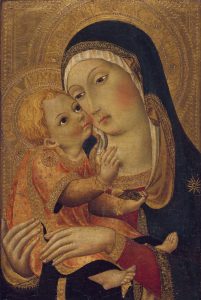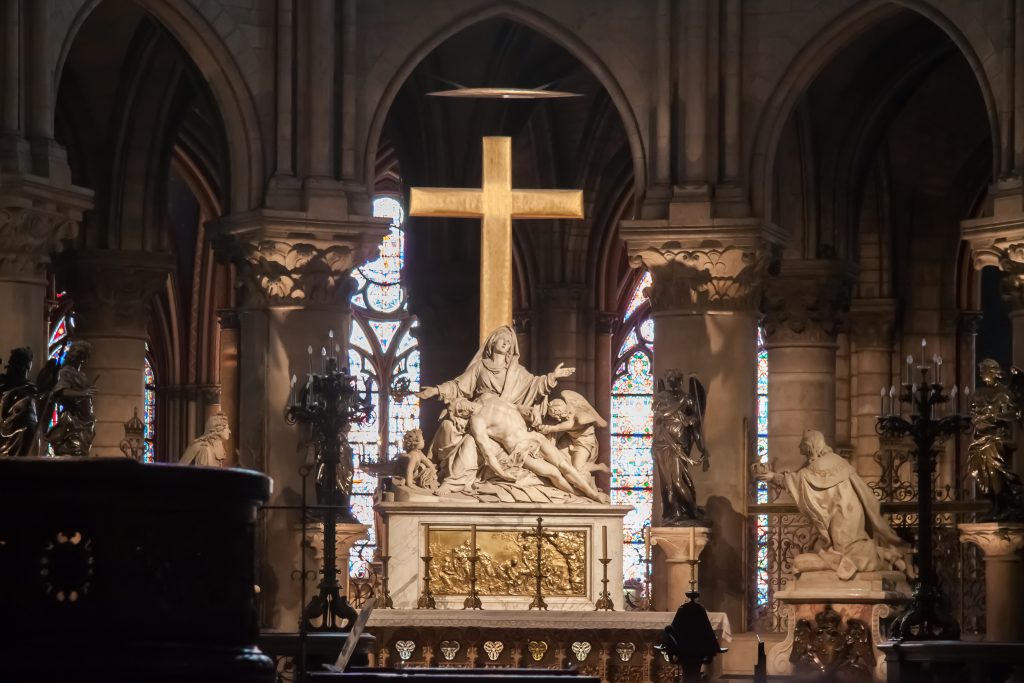I was born at the end of the Baby Boom in a Sicilian neighborhood. Our parish served immigrants from two villages: Serra di Falco and Monte d’Oro. Each village had a feast day, and for both it was Marian: Our Lady of Sorrows and Our Lady of the Rosary.
Every year on the Sundays closest to those feasts, the men of the parish attached a life-sized statue of Mary to a platform, and then carried it through the streets in a procession that stopped traffic and always ended in fireworks.
The processions were an important marker for our identity — as Sicilians and as Catholics. But my generation moved out of the neighborhood, and many of us married out of our tribe.
As we left, we tended to leave behind the markers of ethnic and religious identity. The important identity for us was American, and the old processions didn’t feel American.
American culture was Protestant, and our raucous love for the Madonna seemed conspicuously foreign and lacking in decorum. We wanted to fit in, so we tried to make our religion look American. The Rosary fell out of fashion.
But the trend didn’t last long. Mainline Protestantism soon went into steep decline. And Pope John Paul II appeared on the scene, brandishing his rosary and invoking Mary in everything he proclaimed.
There was a resurgence in Catholic identity, and it was distinctively Marian. Yet it wasn’t at all foreign. In fact, it began to feel American.
So how did that happen? Much in the same way it always has through history.
Mary is a mother, and so she finds a way to stay in the lives of her children. And she finds a way to make them know they are at home in the Church.
In the Gospels, she’s the context for the beginning of the Messiah’s story. She consents to the angel’s proposal, and the Messiah finds his home in her. She acts on his behalf as she welcomes shepherds and magi who arrive to adore him. They find the child with Mary his mother — and that is where all generations since have found him.
Mary shows herself to be a mother throughout the stories of Jesus’ childhood. She anguishes when he’s lost and rejoices upon finding him. St. Luke sums up Jesus’ adolescent years with the observation that he was “obedient” to his parents. That tells us all we need to know about Mary’s character. God himself chose to be obedient to her.
Nevertheless, we find a role reversal at the start of Jesus’ public life. After his baptism, Mary appears as her son’s model disciple. When he was told, "Your mother and your brothers are standing outside, desiring to see you,” he responded: "My mother and my brothers are those who hear the word of God and do it."
Mary was more blessed, then, for her discipleship than for her maternity. She was the one who heard the Word of God and kept it — in the most physical way possible. She became his disciple, yet she remained his mother.
It is she who launched his ministry of wonderworking. She was with her son at a wedding, and the host had run out of wine. She simply pointed out to Jesus: “They have no wine.”
He made the strangest response: “O woman, what have you to do with me? My hour has not yet come.”
God incarnate seems to know the foreordained moment for his manifestation to the world — and that wedding feast was not it. Yet he advanced the moment for his mother’s sake! He turned water into wine, and he saved the celebration.
The moment is significant because it marks the beginning of Our Lord’s miracles, but also because it marks Our Lady’s debut as intercessor. Who could be more reliable in this than the disciple who persuaded God to change his timetable?

After her son’s death and resurrection, at the beginning of the Church’s history, she remains with the disciples in the Upper Room as they await the Holy Spirit
She would be essential to their proclamation. When St. Paul summarizes the Gospel, he says: “God sent forth his Son, born of a woman, born under the law.” Born of a woman. Why is that one of only two details he chooses to include?
As virgin-mother, Mary testifies to Jesus’ full humanity and his full divinity. Her virginity proves that God is his Father — and Jesus is truly divine. Her motherhood proves that Jesus is truly human, with living flesh and blood.
The next time we see Mary is in the Book of Revelation. She is crowned with stars, appearing as a queen, after being assumed body and soul into heaven. This was a rare honor that, according to Jewish tradition, had only been given to Moses and Elijah.
In the New Testament, she is mother, model disciple, intercessor, companion in the Church, and finally, queen of heaven and history. She is a true mother, and so she still engages with the Church through the centuries that follow.
In the first centuries of the Church, she is discussed in the works of St. Ignatius of Antioch and Justin Martyr. St. Irenaeus in France speaks of her as the “undoer of knots” and the New Eve, as does Tertullian in North Africa.
The term “Mother of God” emerges in the archeological record around the year 200, and it soon becomes the most popular form of address for Mary. Only in the fifth century did a Christian raise qualms about the title. He was Nestorius, the bishop of Constantinople, and in his city he ordered the term struck from hymns and prayers.
But he failed. His people held public demonstrations. They complained to the emperor and the pope. They argued that Nestorius couldn’t be right because he was opposing the faith they had learned from their grandparents. They invoked the full weight of Scripture and tradition.
To restore peace, the emperor convoked the Council of Ephesus. At the Council, the bishop of Alexandria, Cyril, demonstrated that the Church had always used the term “Mother of God.” When Nestorius argued that a Mother must precede her Son, Cyril responded with the historical facts: Mary did not precede God, but she undoubtedly mothered him. Scripture refers to her as the mother of Jesus, and Jesus is God.
Nestorius countered that Mary was mother only to Jesus’ human nature and not to his divine nature. In response, Cyril observed that a mother does not give birth to a nature, but to a person, and this person was divine. To separate his divinity from his humanity, as Nestorius was doing, was to divide Christ in two. And that was heresy.
Cyril’s arguments prevailed. And when the bishops emerged from council chambers, they found an enormous throng gathered. Ordinary people had traveled far in miserable heat — because this council was about their mother. When they learned of the bishops’ conclusions, they erupted with joy and sang hymns.
The Council of Ephesus took place in 431 A.D., and it confirmed the Marian devotion of Christians who had lived in every century till then.
Two hundred years after Ephesus, the Christian lands of the East would be overwhelmed by Arab invaders bearing a new religion. That religion, Islam, was imposed by force.
It is at least arguable that the Islamic invaders could not have succeeded, had they not found a way to accommodate the affection of the common people for Jesus and Mary. Thus, both appear in the Koran and in the secondary literature of Islam.
The Irish monks of the dark ages would go on to write hymns to the Virgin and paint her picture in the Gospel Book of Kells. Mary inspired builders to construct the great Gothic cathedrals, many of which were named for her (Notre Dame). She inspired monks to develop new technology for stained glass, to illuminate her image.
In the time of the Black Death, the mid-1300s, Mary appeared everywhere in a new form of art: the pieta. During the plague, hundreds of millions died throughout Europe. The continent was grieving, and suddenly the pieta replaced earlier, more glorious images of the Madonna. Now, Europe prayed before sculptures and paintings of the grieving mother holding the lifeless body of her divine Son. And people saw that she was with them in their sorrow.
With the Protestant Reformation, Mary’s role was eclipsed for many. Martin Luther tried to hold on to the Marian doctrines while abandoning devotions. John Calvin had no such scruples, and he even revived the error of Nestorius in rejecting the title Mother of God.
Yet just as millions were leaving the Church in Europe, millions entered in the New World. Though the conquistadors and missionaries had failed to convert the native peoples, Mary succeeded. In 1531 she appeared at Guadalupe to a poor man named Juan Diego. And she accomplished what money and laws could never do. She converted a continent in a matter of a few years.
Then, forty years later, she saved fractured Europe from succumbing to Muslim invaders. As the Ottoman fleet advanced, Pope Pius V roused the Catholic people to pray the Rosary. And on October 7, 1571, at the Battle of Lepanto, Christendom’s ragtag navy prevailed over the Sultan’s fleet. The Blessed Virgin — and an army of common people praying their beads — received credit as a new feast day was added to the calendar.
The story continues into the modern era. There have been apparitions — at Rue de Bac, Lourdes, Fatima, and elsewhere.
And the future?
I see it in an image of Mary I keep in my office. It’s from India, and it is painted on a pipal leaf.
The Church is growing. Though it seems weakened in the West, it is growing in the global South and East. The painting on the pipal leaf is a sign of that growth and the future’s promise. Every crisis in Church history has led to surprising developments — often brought about not by the rich and powerful, but by poor people who stand with Mary and pray … and are pleased to make some noise as they carry her image through the streets.

